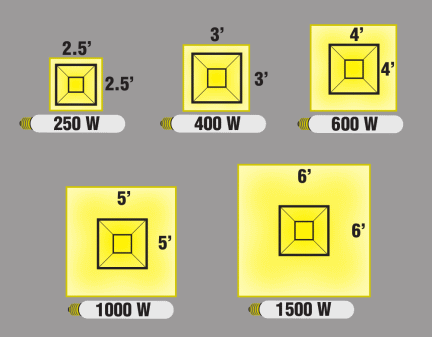
Introduction
A grow light is probably one of the most exciting purchases any new grower can make. Whether used as a complete replacement for the Sun, or to supplement natural light levels, there are several different kinds of grow light available so it’s important to choose the size and type best suited for your application: i.e. propagating young plants, promoting vegetative growth, and driving flowering and fruiting.
Essential Concepts
Heating and Cooling
Grow lights produce heat as well as light. If plants grow too close to your grow lights they can suffer from excess heat and localized low humidity. T5 fluorescent lights produce less heat and are less intense so they can be placed closer to plants than high intensity discharge (HID) lights. Many growers choose air-cooled reflectors to mitigate the heat issues that are sometimes associated with HID lights.
Lamp Depreciation / Maintenance
Lamps need to be replaced regularly (every 6-9 months) to maintain optimum growth rates in your indoor garden. Don’t be fooled: while your grow lights may appear no dimmer to the naked eye, they are dramatically less efficient. It’s also important to keep reflectors clean.
Intro to Different Types of Grow Lights
T5 (H0, VH0) Fluorescents
 Grow lights produce heat as well as light. If plants grow too close to your grow lights they can suffer from excess heat and localized low humidity. T5 fluorescent lights produce less heat and are less intense so they can be placed closer to plants than high intensity discharge (HID) lights. Many growers choose air-cooled reflectors to mitigate the heat issues that are sometimes associated with HID lights.
Grow lights produce heat as well as light. If plants grow too close to your grow lights they can suffer from excess heat and localized low humidity. T5 fluorescent lights produce less heat and are less intense so they can be placed closer to plants than high intensity discharge (HID) lights. Many growers choose air-cooled reflectors to mitigate the heat issues that are sometimes associated with HID lights.
High Intensity Discharge (HID) Grow Lights
 HIDs are the most commonly used type of grow light in indoor gardens. As their name implies they produce a very intense light that is capable of penetrating deeper into the plant canopy than fluorescent grow lights. HIDs are commonly available between 250W and 1500W. By far the most common are 1000W. There are two main types of lamp used in HID applications: Metal Halide and High Pressure Sodium. Indoor gardeners use both types of light for different parts of the plant life cycle.
HIDs are the most commonly used type of grow light in indoor gardens. As their name implies they produce a very intense light that is capable of penetrating deeper into the plant canopy than fluorescent grow lights. HIDs are commonly available between 250W and 1500W. By far the most common are 1000W. There are two main types of lamp used in HID applications: Metal Halide and High Pressure Sodium. Indoor gardeners use both types of light for different parts of the plant life cycle.
Growers use metal halide lamps to grow up their plant after the propagation stage. They are rich in the blue part of the spectrum—ideal for the structural growth before the flowering phase.
High pressure sodium lamps are more efficient and intense than metal halide lamps. They are rich in the orange / red part of the spectrum and can be used for vegetative growth but are more typically used for the flowering and fruiting stage.
BEFORE YOU BUY: Check that your ballast is compatible with your lamp and that it is rated to run at the correct power.
Which T5 Fixture?
In order to make an informed decision when choosing a grow light it’s important to have a basic understanding of some fundamental lighting principles. Don’t skip this part!
Spectrum
Light is made up of different wavelengths measured in nanometers (nm.) The band of the spectrum between 400 and 700 nm is called “Photosynthetically Active Radiation” (PAR) — this refers to the band of light that plants capture and use. Light rich in the “blue” part of the spectrum (around 440-490 nm) is ideal for vegetative growth, whereas “orange / red” light (around 580-700 nm) helps to promote flowers and fruit.
Intensity
The right kind of light (PAR) needs to be sufficiently intense in order to “power” your plants. Different types of grow light produce a wide range of intensities. Correct positioning is therefore very important. For all grow lights, the further they are from your plants, the less usable energy reaches the leaves. Light intensity greatly affects plant growth patterns.
Power
The electricity used to power grow lights is measured in watts (W). Power consumption can vary enormously between different types. For instance: a 2ft T5 fluorescent tube can use as little as 24W, where the most powerful high intensity discharge (HID) lights can use as much as 1500W.
Footprint
The effective surface area covered by a grow mlight. If you hang your grow light higher, its footprint will increase but the intensity of light hitting the leaves (luminous flux) will decrease exponentially.
Photoperiod
The amount of light in a 24-hour period. Many plants use photoperiod as a cue to start producing flowers and fruit. Therefore indoor gardeners can manipulate many plant species simply by altering how long they switch their grow lights on for each day, mimicking the natural seasons, by connecting their lights to 24-hour timers and relays.
Essential Concepts
Effective Illumination
for Various Wattage HIDs


